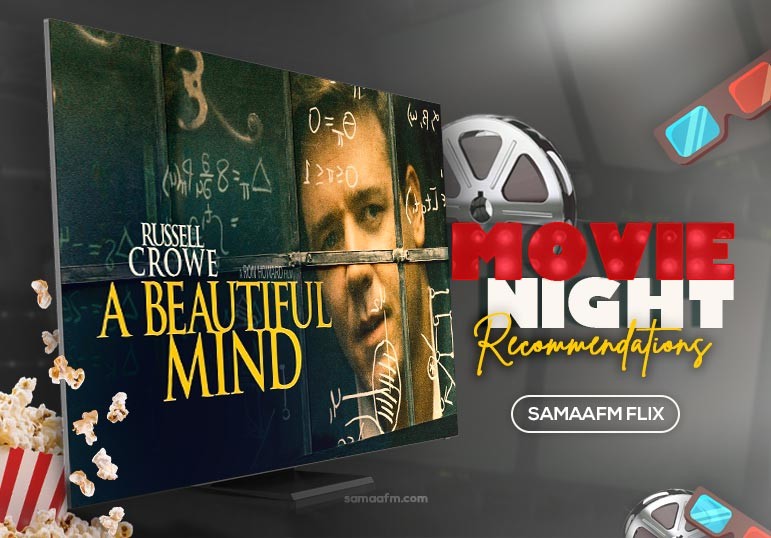
Friday Flix Movie Review: A Beautiful Mind
- posted by: Abdul Latif Dadabhouy
- No Comments
From Math to Madness and back, the movie ‘A Beautiful Mind’ is different, why do I say different, because Schizophrenia is portrayed amazingly. But is it reality what we see in movies rather than reality? Before jumping both feet into the movie let me give you a little overview of Schizophrenia.
Schizophrenia
Schizophrenia is a serious mental disorder in which people interpret reality abnormally. This condition leads to suicidal ideation with psychosis. Schizophrenia may result in some combination of hallucinations, delusions, and extremely disordered thinking and behavior that impairs daily functioning, and can be disabling.
Cast And Crew
The cast includes Russell Crowe, Jennifer Connelly, Ed Harris, Christopher Plummer, Paul Bettany, Adam Goldberg, Josh Lucas, Anthony Rapp, Jason Gray-Standford, Judd Hirsch, Austin Pendelton, and, Vivien Cardone.
Plot
A Beautiful Mind’s perspective on schizophrenia buys in unhesitatingly to the Stephen Hawking thought of disability: it is OK as long as it betokens some extraordinary mental or otherworldly predominance.
“A Beautiful Mind” stars Russell Crowe as Nash, and Jennifer Connelly as his better half, Alicia, who is pregnant with their child when the first side effects of his illness become clear and apparent. It recounts the narrative of a man whose brain was of colossal help to mankind while simultaneously sold out him with terrifying hallucinations. Crowe rejuvenates the character by evading emotionalism and working with little social subtleties. He shows a man who plummets into a frenzy and then, out of the blue, recaptures the capacity to work in the scholastic world. Nash has been contrasted with Newton, Mendel, and Darwin, but at the same time was for a long time simply a man mumbling to himself in the corner.

Director Ron Howard is able to show the goodness in Nash that inspired Alicia and others to remain by him, to keep trust and, in her words at his breaking point, “to believe that something extraordinary is possible.” The film portrays Nash as a calm and presumptuous young man with a West Virginia strong accent, who bit by bit transforms into a tormented, cryptic distrustful, and paranoid man who accepts he is being followed by government specialists. Crowe, who has an uncanny capacity to adjust his look to fit a job, consistently appears to be persuaded as a man who ages 47 years during the entire film.
The early Nash, seen at Princeton in the last 1940s, serenely tells a grant winner “there is not a single seminal idea on either of your papers.” When he loses at a game of Go, he clarifies: “I had the first move. My play was perfect. The game is flawed.”

The Breaking Point
He knows about his effect on others and reviews that his 1st-grade teacher said he was “born with two helpings of the brain and a half-helping of heart.” It is Alicia who causes him to discover the heart. She is an alumni student when they meet, is pulled in to his genius, is moved by his sadness, can acknowledge his concept of romance when he tells her about his love. To the extent he appears to be caught inside himself, with that, Nash’s schizophrenia takes a strict, visual form.
He believes he is being followed by a federal agent (Ed Harris) and imagines himself in chase scenes that seem inspired by 1940s crime movies. He starts to discover patterns where no patterns exist. One night he and Alicia stand under the sky and he asks her to name any object, and then connects stars to draw it. Romantic, but it’s not so romantic when she discovers his office thickly papered with countless bits torn from newspapers and magazines and connected by frantic lines into imaginary patterns.
What I believe is that movies in general have a method of driving mental illness into corners. It is bizarre, exciting, charming, interesting, lamentable, or sometimes unreasonable. Here it is basically an illness, which renders life yet not exactly unimaginable for Nash and Alicia before he gets one of the fortunate ones to pull out of the downward spiral.
The movie also beautifully traces the treatment of Nash by a very smart psychiatrist Dr. Rozen (Plummer) and his agonizing course of insulin shock therapy. The medication helped him improve somewhat, but only when he takes it. The movie fascinates us about the life of this man, who despite all works hard to achieve.
The film portrayed Nash’s mind hallucinates as to a great extent visual; Nash himself announced that his delusions were generally hear-able and mental. The screenwriter, Akiva Goldsman, thought about the visual hallucinations as a technique for giving the viewers the vibe of encountering dreams and his hallucinations. In spite of the fact that in all actuality Nash evidently had a remission of his psychological instability, in the film the character says that he is taking a newer medication. This was a decision made by the director all together not to give the feeling that abandoning medicine was an appropriate strategy for managing schizophrenia.
So are you planning to watch the movie this weekend? Give it a try and let us know in the comments section below!
RECOMMENDED MOVIES
If you like this review you can also check our Friday Flix segment




